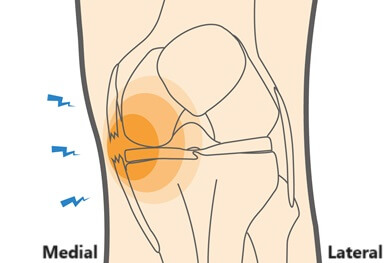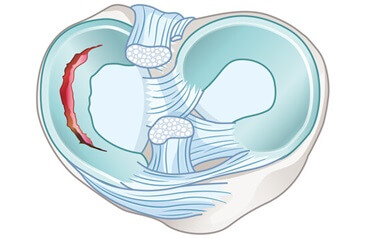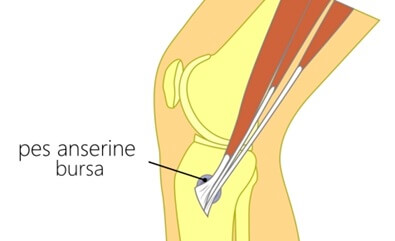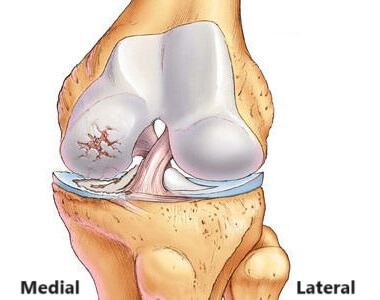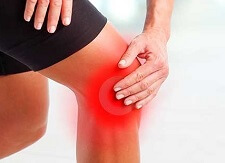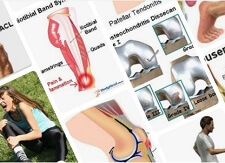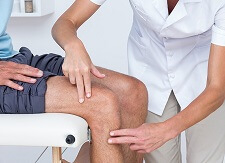- Home
- Knee Pain Diagnosis
- Medial Knee Pain
Medial Knee Pain
Written By: Chloe Wilson, BSc(Hons) Physiotherapy
Reviewed by: KPE Medical Review Board
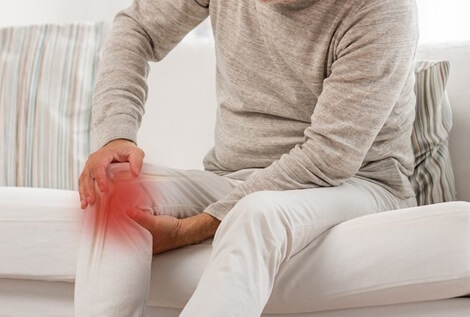
Medial knee pain is a common problem that causes pain on the inner side of the knee.
There are lots of different structures that can cause inner knee pain. Symptoms may come on gradually over time or may develop suddenly after a knee injury.
Inner knee pain may be sharp, dull, constant, intermittent, associated with swelling or restricted movement.
Here we will look at the common causes and symptoms of medial knee pain, how to work out which one you have and the best treatment options.
What Causes Medial Knee Pain?
The most common causes of inner knee pain are:
- MCL Sprain/Tear: Overstretching of the inner knee ligament
- Meniscus Tear: damage to the cartilage lining the knee
- Pes Anserine Bursitis: inflammation on the inner side of the knee
- Knee Arthritis: Wear and tear of the bones and cartilage
- Plica Syndrome: inflammation of the synovial lining
- Bone Spurs: Excess growths of bone that stick out
- Hamstring Tendonitis: Inflammation of hamstring tendon
Each of these causes of medial knee pain will present slightly differently and will require specific treatment.
1. MCL Tear
An MCL tear is the most common cause of medial knee pain, particularly in people under the age of 50.
With an MCL tear, there is damage to some or all of the fibers of the medial collateral ligament on the inner side of the knee.
MCL tears are one of the most common medial knee injuries in sports, usually from either a force through the outer side of the knee or twisting the knee while the foot is fixed to the ground e.g. with cleats.
Typical symptoms of an MCL tear include:
- Medial Knee Pain: particularly when bending the knee, walking, going up and down stairs or playing sports
- Swelling: bruising and tenderness over the injured ligament
- Knee Instability: the knee may feel like it is going to give way, particularly with twisting movements
- Knee Stiffness: knee movement may be limited
There are three grades of MCL tear, depending on how severely you have damaged the ligament and treatment usually involves a combination of PRICE, knee brace, exercises and physical therapy.
Find Out More: MCL Tears
2. Medial Meniscus Tear
Another common cause of medial knee pain is a tear in the thick cartilage that lines the inner side of the knee joint, known as the meniscus.
Typical features of a medial meniscus tear include medial compartment pain, swelling, locking (where the knee gets stuck), instability and difficulty straightening the leg.
Symptoms typically get worse with walking, running, squatting and on stairs, especially going up. Meniscus tears may develop:
- Suddenly: usually from awkward twisting or a force through the knee
- Gradually: over a period of weeks or month due to wear and tear in the knee
Treatment for an MCL medial knee injury usually consists of rest, ice, compression, elevation, strengthening and stretching exercises and physical therapy. If the ligament tears completely, then surgery may be necessary to repair the damage.
Find Out More: Meniscus Tears
3. Pes Anserine Bursitis
Another cause of inside knee discomfort is inflammation of the pes anserine bursa, a small fluid-filled sac the reduces friction, can also cause inner knee pain.
In most cases of pes anserine bursitis, there is:
- Gradual onset of medial knee pain, around 2-3 inches below the knee joint
- Inner knee swelling
- Knee stiffness & weakness
- Sleep may be affected
Inner knee pain from pes anserine bursitis usually gets worse with resisted knee flexion and exercise, as well as when climbing stairs. It most commonly affects overweight middle aged women or runners and swimmers.
Treatment usually involves a combination of rest, ice, stretching and strengthening exercises to reduce the medial knee pain and regain stability at the knee. In some cases, your doctor may advise corticosteroid injections or even surgery.
Find Out More: Pes Anserine Bursitis
4. Knee Arthritis
Wear and tear in the cartilage lining the medial side of the joint from knee arthritis is the most common cause of medial knee pain in the over 50's.
Arthritis is more prevalent in the inner side of the knee, rather than the outer side due to the angles at the hip, knee and ankle.
Symptoms of medial knee arthritis typically develop gradually and include
- Morning stiffness in the knee
- Inner knee pain
- Swelling
- Clicking/grinding sensations
- Knee stiffness
Medial knee pain from arthritis tends to be worse after prolonged rest and in cold weather.
There are three stages of arthritis, mild, moderate and severe based on how badly the joint is affected.
Knee arthritis treatment will depend on the severity of the symptoms but typically includes exercises, medication, heat/ice, acupuncture, injections and knee braces.
Find Out More: Knee Arthritis
5. Medial Plica Syndrome
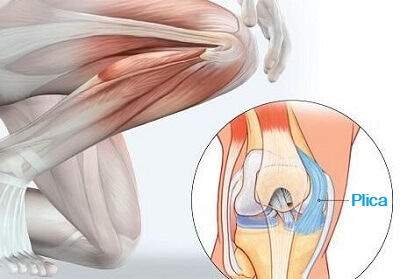
One of the more unusual causes of medial knee pain is inflammation of the synovial membrane (plica) on the inner side of the knee.
With medial plica syndrome there tends to be anterior and medial knee pain and tenderness, and some people notice an audible clicking sound when they move their knee.
Inner knee pain due to inflamed plica usually gets worse with repetitive knee movements, squatting, on stairs and when getting up after you've been sitting or lying down for a while.
A combination of knee exercises, anti-inflammatory medication, rest and ice is usually sufficient to reduce the medial knee pain and inflammation, but in severe cases, surgery may be necessary to remove the injured plica.
Find Out More: Plica Syndrome
6. Knee Bone Spurs
A common cause of medial knee pain in people over the age of 60 is knee bone spurs.
Bone spurs are extra outgrowths of bone that form lumps, typically towards the inner edge of the knee bones. Irritation from repetitive wear and tear and cartilage causes the body to lay down excess bone to try and prevent the joint from further damage.
Knee bone spurs may not cause any symptoms initially but as they increase in size and project into the joint they can cause irritation and friction leading to medial knee pain and stiffness.
Bone spurs can occur anywhere in the knee but are particularly prevalent on the inner side of the joint due to more pressure going through the medial knee.
Find Out More: Bone spurs in knee section.
7. Hamstring Tendonitis
Medial knee pain that is at the back of the knee may be due to hamstring tendonitis.
Hamstring tendonitis is an overuse injury which causes inflammation and irritation of one of the two hamstring tendons on the inner side of the knee:
- Semitendinosus Tendonitis: inner posterior knee pain
- Semimembranosus Tendonitis: inner posterior knee pain, slightly lower down and more central
Hamstring tendonitis usually affects atheletes and runners where repetitive stress is frequently placed through then tendon e.g. jumping, kicking, running and cycling.
Find Out More: Hamstring Tendonitis
Diagnosis: What Is Causing My Inner Knee Pain?
Let's have a look at the common symptoms associated with medial knee pain and what they typically indicate to help you make a diagnosis:
Pain On Inside Of Knee No Swelling
Pain On Inside Of Knee No Swelling
If you have inner knee pain but no swelling, it is likely only a minor injury such as a small cartilage tear, small bone spurs or a grade 1 MCL sprain. Symptoms should settle down quickly with rest, ice and exercises.
Inner Knee Pain Running
Inner Knee Pain Running
Medial knee pain during or after running is most typically caused by a cartilage tear, hamstring tendonitis or Runners Knee.
Inner Knee Pain When Straightening Leg
Inner Knee Pain When Straightening Leg
Pes Anserine Bursitis is the main cause here as the bursa can easily get squashed when straightening the knee, at any phase of the movement.
Medial Knee Pain With Flexion
Medial Knee Pain With Flexion
Most medial knee pain gets worse with knee flexion, especially when weight bearing through the leg. If it's worse when standing, it may indicate an MCL tear, bone spurs or meniscus tear. If it happens when you are sitting or bending the knee, it may be pes anserine bursitis or plica syndrome.
Anterior Medial Knee Pain
Anterior Medial Knee Pain
If your inner knee pain is coming round to the front of the knee, it may actually be a problem with the knee cap or Runners Knee rather than one of the structures on the inner knee.
Medial Knee Pain When Sitting Cross Legged
Medial Knee Pain When Sitting Cross Legged
Pain in the inner side of knee when sitting cross legged is most likely due to a meniscus tear as this position places extra stress on the cartilage.
Medial Knee Pain After Sitting or Lying
Medial Knee Pain After Sitting or Lying
Inner knee pain that is at its worse when you first move the knee after sitting or lying down for a while tends to be due to knee arthritis. The pain usually eases once you are up and about. In younger patients, it is more likely to be due to Plica Syndrome.
Medial Knee Injuries
Medial Knee Injuries
The most common medial knee injuries are MCL tears and medial meniscus tears, which often both happen at the same time as a result of awkward twisting or sporting injuries.
Why Is Medial Knee Pain So Common?
Medial knee injuries are really common because muscle weakness and/or tightness, which is very common, can subtly change the way the knee moves.
This causes more force to go through the inner side of the joint, rather than distributing weight evenly through the whole joint, which results in damage to the inner side of the knee and therefore results in medial knee pain. For example, it is much more common to get osteoarthritis on the inner side of the knee than the outer side.
Medial knee pain may be associated with some knee swelling. If there is pain on inside of knee but no swelling, it is likely only a minor injury that should settle down soon. If there is more significant inner knee swelling, it often indicates a more severe injury that may take longer to recover from.
Want to Know More?
If there is swelling or inflammation alongside your medial knee pain, check out the Swelling On Side Of Knee article.
Just because there is inner knee
pain, doesn’t necessarily mean the problem is on the inner side of the
joint. Pain can refer from different places such as the knee cap or even the lower back. If you pain is further up your leg, have a look at the inner thigh pain article.
If your inside knee pain doesn’t sound quite like any of these problems, visit the Common Causes of Knee Pain section to find out about the most common knee problems.
You might also be interested in the following articles:
- Knee Pain & Popping
- Swollen Knee Treatment
- Front Knee Pain
- Outer Knee Pain
- Pain Above Knee
- Pain Below Knee
- Burning Knee Pain
- Knee Range Of Motion
- Knee Pain On Stairs
Alternatively, if would like some guidance with working out what is causing your problem, visit the knee pain diagnosis chart for help.
Remember, you should always see a doctor with any new onset of pain. To find out more about these common causes of medial knee pain, choose from the links above.
Related Articles
References
1. Journal of Orthopedics. Medial collateral ligament injuries. August 2017
2. The Surgery Journal. Synovial Plica Syndrome of the Knee: A Commonly Overlooked Cause of Anterior Knee Pain. February 2017
3. Arthritis Research & Therapy Journal. Functional electrical stimulation of gluteus medius reduces the medial joint reaction force of the knee during level walking. November 2016
4. Muscles, Ligaments and Tendons Journal. Meniscus tear surgery and meniscus replacement. May 2016
Last Updated: May 21st, 2025
Next Review Due: May 21st, 2027
